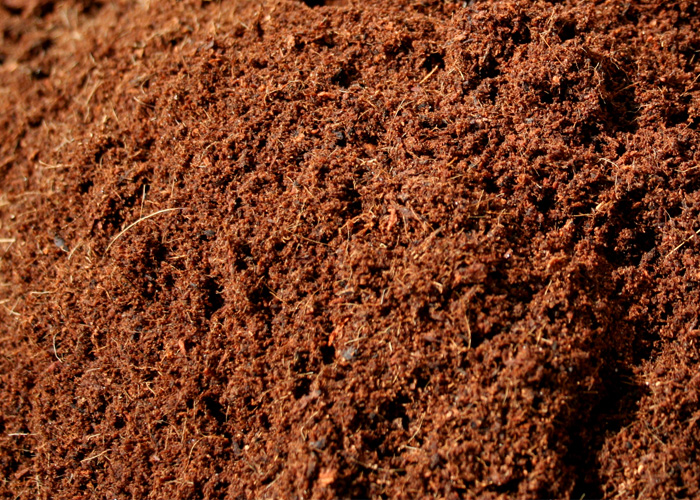
Coco Peat Price In Kenya
Grekkon Limited’s coco peat price in Kenya is per kg of dry material. As the largest coco peat supplier in Kenya, we keep the moisture level to the lowest level for greater value. The fiber content varies according to the growers need because we tailor this. Our coco peat for sale in Kenya is available from 5kg bags, and our cost of coco peat in Kenya is as wholesale or retail
Advantages of coco noir
- It is easy to make
- When well treated, it has near zero diseases and pests
- It is easily available
- Seedlings established in, or plants grown hydroponically in coco peat grow 50% faster than in soil. This is because it is highly porous allowing for vigorous root growth and rot air supply
- It has a high water holding capacity
- It is environmentally friendly because it is a 100% natural product
- Coco peat neutralises soil acidity
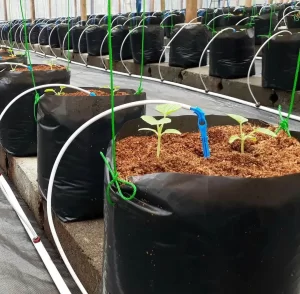
Coco peat growing medium in a hydroponic unit
Disadvantages of coco noir
- It is a more expensive option than soil
- If not well treated, it can harbor pests and diseases
- Getting the right EC and moisture levels is difficult
- It is rich in sodium and potassium salts
- It requires treatment
How to make coco peat soil
- Collect coconut husks
- Cut them up to smaller pieces
- Clean them in water to remove dirt and other debris
- Sun dry them
- Run them in the grinding machine
- Sieve the product to separate the coco peat from the fibers. The choice of sieve depends on the amount of fiber needed in the final product
We process our coco peat in Kilifi and Kwale counties, empowering hundreds of coconut farmers who supply our processing plant with raw material. Our production process provides the best coco peat for sale in Kenya. The final material is applied my hundreds of farmers for production of seedlings and mature crop growing. The table below provides details of our final coco peat material after processing
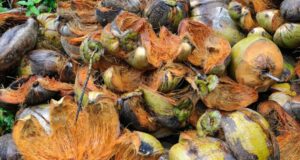
Coco Peat Price In Kenya:
Cost of Coco Peat and Material Specs Tabulation
| 1kg of coco peat (loose) | Kes 80 |
| PH | 6.3 – 6.7 |
| Electrical conductivity (EC) | 1.6 – 2.0 |
| Expansion ratio | 2.5 – 3 |
| Moisture content | <5% |
| Compression volume | 28L |
| Fiber content* | <3% |
| Sand content | <1% |

A 5kg block of treated coco peat is Kes 600
* the fiber content is tailored to the growers need. Seedling nurseries require <3%, while potted plants or a growing crop will do up-to 30%
Our coco peat price is discounted for large volume purchases
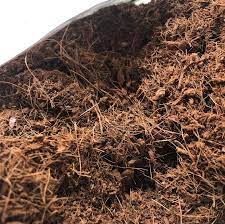
High fiber
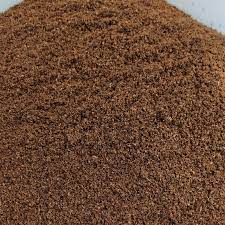
Low fiber
Coco Peat Price In Kenya
FAQs
I. How do you treat coco peat before planting?
Step 1.
Soak it overnight in water. Unwashed coco peat has high levels of sodium, potassium and chloride which make it highly saline. High salinity = high pH (>7.0). High salinity locks up many nutrients making them unavailable to the crop
Step 2.
Dissolve 2.5g of calcium nitrate for every liter of water. This is arrest excess sodium or potassium chloride salts in it, and to increase nitrogen. Again, plants grown in coco peat tend to become deficient in calcium or magnesium as they grow
Step 3.
Rinse it in running water until the brown coloration disappears
In nurseries, coco peat is input in seedling trays, while in greenhouses, this is in troughs.
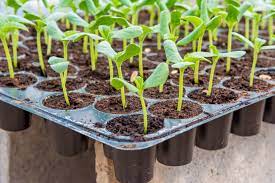
Seedlings germinated on low fiber
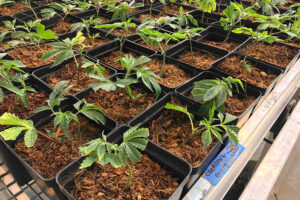
A crop grown on high fiber coco peat
II. How much does 1kg coco peat expand?
1kg of coco peat expands to 5kgs
III. Can I plant directly in coco peat?
No because it does not have nutrients for the crop. This is only possible under hydroponic growing where nutrients are supplied to the crop often. Coco peat alone is used for germinating seeds
IV. What are the disadvantages of coco peat?
- it is high in potassium
- if not properly sanitised, it will harbour pests and diseases
- it is more costly to germinate wit than soil
- during processing, it is difficult to attain the right pH and moisture content
V. How long can coco peat last?
Coco peat begins to break down after 10 years. It is therefore be reused over 4 years, because it resists accumulation of crop harmful bacteria and fungi
VI. Can we mix coco peat and soil?
Yes, at a ratio of 3 parts of soil to 1 part of coco peat. This is done as a soil amendment measure; to loosen the top soil
VII. Can seeds germinate in coco peat only?
Yes, coco peat is perfect medium for seeds germination. This is because it re-wets very easily

Soil mixing with coco peat. Observe a soil to coco peat ratio of 3:1
VIII. How much water do you put in coco peat only?
Apply water at a ration of 3.5litres for every 5kgs of coco peat
IX. Can I use coco peat only instead of soil?
Yes in hydroponic crop production. Crops under hydroponic production grow 50% faster than they would in soil
X. Which plants grow well in coco peat?
Potted plants, and ornamentals such as ferns, cactus, orchids, bromeliads, anthuriams and others
XI. Do you need to wash coco peat?
Yes to remove excess salts. Clean it in running water until the water is clear
XII. Is growing in coco peat better than in soil?
It is better, but expensive because nutrients and water have to be added frequently. Coco peat has little and few nutrients of its own, and it dries out fast. Hydroponic plants grown with coco peat grow faster, they have higher yields, they enjoy a neutral pH, and their roots extend easily
XIII. How often do you water coco peat?
Every 4 to 5 days
XIV. What is the best fertiliser for coco peat?
Granular NPK fertiliser with a ratio of 2-1-1 is best. Apply both fast and slow nitrogen releasing fertilisers
